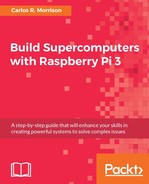The Raspberry Pi2 model B (see the following figure) has a few siblings. Some are less capable than the Pi2, and others, such as the newer Pi3, have greater capability in terms of processing power. However, in the following endeavor, the author used the Pi2, even though he could have used the Pi3 (the Pi3 is discussed in the latter sections of Chapter 8, Testing the Super Cluster). The Pi technology was invented in the United Kingdom in February 2012. The device is the progeny of an idea - conceived at the Raspberry Pi foundation - that places of learning around the UK should be equipped to teach individuals the basics of computer science. The low-cost technology quickly gained popularity in England, and subsequently in the US. Contributing affirmatively to the device's rapid acceptance is its use of an opensource Linux-based operating system. The Linux OS is a boon to tech geeks around the world, who are now using this Pi microcomputer in ways that were never imagined by its developers, such as the supercomputer that you will be constructing shortly. You may visit the Raspberry <ie>Pi</ie> website, https://www.raspberrypi.org, to see a myriad of other ways in which this capable little device can be used. Additional technical details about the Pi2 may also be gleaned from the Adafruit links https://cdn-shop.adafruit.com/pdfs/raspberrypi2modelb.pdf and https://cdn-learn.adafruit.com/downloads/pdf/introducing-the-raspberry-pi-2-model-b.pdf, and the Pi organization website, https://www.raspberrypi.org/products/raspberry-pi-2-model-b/.
The following figure depicts the top view of the Raspberry Pi2 showing the aluminum cooling fins affixed to the Ethernet controller microchip, and the larger broadcom Central Processing Unit (CPU) microchip:

Raspberry Pi2 model B, top view
The following figure depicts the bottom view of the Raspberry Pi2; note the SD card in its holder/slot located at the center-left of the PC board, and the RAM chip (square black component) located at the approximate center of the board:

Raspberry Pi2 model B, bottom view
The Pi2 B has a four-core CPU, capable of running one processing thread per core, and 1 GB of Random Access Memory (RAM), located approximately at the center of the bottom of the board. Each CPU core operates at 900 MHz clock speed, that is, the processor executes at 900,000,000 Cycles Per Second (CPS) (the relationship between CPS and Floating Point Operations Per Second (FLOPS) can be gleaned from the websites https://en.wikipedia.org/wiki/FLOPS and https://www.quora.com/How-do-you-convert-GHz-to-FLOPS). Nevertheless, you can overclock the Pi2 (not the Pi3, its clock speed is fixed at 1.2 GHz) to operate at 1 GHz (you will be instructed on how to accomplish this speed upgrade later). This higher overclocked processing speed will produce an elevated temperature within the CPU. You can, however, mitigate this heating issue by simply attaching cooling fins to the surface of the chips, and thereby extending the life of the processor. The fins can be purchased from Amazon, Adafruit, or any other online store that sells the Pi boards. It should be noted that, for the pending effort, the more advanced, and slightly less expensive Pi3, https://www.raspberrypi.org/products/raspberry-pi-3-model-b/, could have been substituted for the Pi2.
